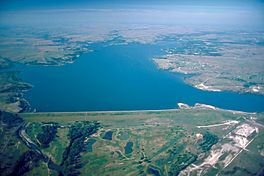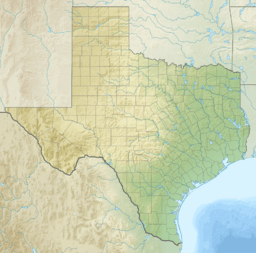Benbrook Lake facts for kids
Quick facts for kids Benbrook Lake |
|
|---|---|

Lake and Dam
|
|
| Location | Tarrant County, Texas |
| Coordinates | 32°37′57″N 97°27′52″W / 32.63250°N 97.46444°W |
| Type | reservoir |
| Primary inflows | Clear Fork, Trinity River |
| Primary outflows | Clear Fork, Trinity River |
| Catchment area | 429 sq mi (1,110 km2) |
| Basin countries | United States |
| Surface area | 3,770 acres (15.3 km2) (normal pool) 7,630 acres (30.9 km2) (flood pool) |
| Water volume | 88,250 acre⋅ft (0.10885 km3) |
| Surface elevation | 694 ft (212 m) (normal pool) 724 ft (221 m) (flood pool) |
Benbrook Lake, also known as Benbrook Reservoir, is a large reservoir in Tarrant County, Texas, USA. It was created on the Clear Fork of the Trinity River. The lake is about 10 miles (16 km) southwest of downtown Fort Worth. The Benbrook Dam holds back the water to form the lake. The U.S. Army Corps of Engineers manages both the lake and the dam.
Building Benbrook Lake
Why the Lake Was Built
Big floods on the Trinity River caused lots of damage in 1908, 1922, and 1936. These floods were the main reason why the U.S. Army Corps of Engineers decided to build flood control projects in North Texas.
The Benbrook Dam and Lake were built by the Galveston District of the Corps of Engineers. After World War II, the U.S. Congress approved building several lakes. These included Benbrook Lake, Grapevine Lake, Lavon Lake, and Ray Roberts Lake. They also improved Lewisville Lake. These projects were meant to control floods and help with river navigation.
Another big reason for building the lake was the idea of a shipping channel. Businesses wanted a deep canal for ships along the Trinity River. This channel would run from the Gulf Coast all the way to Dallas and Fort Worth. It would connect to the Houston Ship Channel.
Today, a shipping channel exists up to about 41 miles (66 km) inland. Even though it's not likely, a channel linking Fort Worth to the Gulf of Mexico could still be built.
Water for Cities
Water that was once planned for this shipping channel is now used for cities. In 1992, the Tarrant Regional Water District gained these water rights. Now, they provide water to the cities of Benbrook, Fort Worth, and Weatherford. This Water District also built pipelines. These connect Benbrook Lake to Fort Worth’s Rolling Hills water plant. They also link to Cedar Creek and Richland-Chambers reservoirs.
Dam Construction Details
Construction of the Benbrook Dam started in May 1947. It was mostly finished when the floodgates closed in September 1952. The lake then began to fill with water. The total cost to build the lake was $14.5 million. This would be about $112 million in 2007.
The dam is a long, rolled-earth wall. It is 9,130 feet (2,783 m) long, including a concrete spillway. The dam rises 130 feet (39.6 m) above the riverbed. Its top is 747 feet (227.7 m) above sea level.
Two large sliding gates control how much floodwater is released. These gates are 6.5 feet (2 m) by 13 feet (4 m). They are operated by electric hoists. Two smaller pipes, 30 inches (0.76 m) wide, release low flows. These keep the river flowing downstream. The concrete spillway for uncontrolled releases is 500 feet (152 m) long. It has a 100-foot (30 m) notch in its center.
Lake Size and Levels
At its normal level, called the conservation pool, the lake is 694 feet (211.5 m) above sea level. At this level, the lake covers 3,770 acres (15 km²). If the lake reaches its maximum flood pool level of 724 feet (220.7 m), it would cover 7,630 acres (31 km²). This 724-foot level is also the top of the spillway's center notch.
During the planning, engineers considered building the dam in a slightly different spot. This spot was near the current I-20 bridge. It was 3.7 feet (1.1 m) downstream from where it was finally built.
Building the dam involved more than just the structure itself. Several railroads, roads, and bridges had to be moved. Utility lines and cemeteries were also relocated. The biggest job was moving six miles (10 km) of the Gulf, Colorado and Santa Fe Railway. Graves from seven cemeteries were moved to the Benbrook municipal cemetery.
Flooding and Lake Operations
How the Lake Prevents Damage
In May 1949, a flood in Fort Worth killed eleven people. It also cost local businesses $11 million. This happened as the dam construction was just beginning.
In a spring flood in 1957, the new lake and the downtown floodway saved $9.3 million in damages. This almost paid back the original cost of building the lake. During this flood, the lake filled to its normal level of 694 feet (211.5 m) for the first time on May 12, 1957. The spillway level of 710 feet (216.4 m) was reached on May 26 that year. The lake reached a record high of 713.35 feet (217.4 m) on June 6, 1957.
This record lasted for 32 years. But then it was broken twice in less than a year, between June 1989 and May 1990. The current record lake level is 717.5 feet (218.7 m) above sea level. This happened on May 3, 1990.
Benbrook Lake has prevented over one billion dollars in flood damages since 1989. When the lake holds floodwaters, its level rises above the normal 694 feet (211.5 m). This often means that park roads and other facilities have to close for a long time.
Flood Predictions and Reality
Engineers who designed Benbrook Lake thought the lake would reach the 710-foot (216.4 m) spillway level only about every 40 years. They also estimated that levels of 715 feet (217.9 m) or higher would happen only once every 100 years.
These estimates show how unusual the floods were in May 1989 (717 feet/218.5 m), May 1990 (718 feet/218.8 m), and December 1991 (713 feet/217.3 m).
How Flood Control Works
The main idea of a flood control lake like Benbrook Lake is to hold back floodwaters. These waters come from heavy rains. By holding them above the dam, the lake reduces river flows downstream. This prevents property damage and losses in cities.
However, the lake levels above the dam rise, and areas around the lake get flooded. So, flooding isn't stopped, but its location is controlled. It happens along the undeveloped lakeshore upstream of the dam, instead of in populated areas downstream.
Water is released from Benbrook Lake mainly through a 13-foot (4 m) wide gated pipe. This pipe is at the southeast end of the dam. If waters rise too fast for this pipe, the lake may flow over the uncontrolled spillway. This spillway is at the northwest end of the dam.
The spillway is a 500-foot (152 m) wide concrete wall. It has a 50-foot (15 m) wide, 14-foot (4 m) deep notch in its center. As of 2005, the lake has only been high enough to flow over this notch five times. The lake has never been high enough to go over the entire width of the spillway. This is expected, as the spillway was designed for this to happen only during a 100-year flood.
1957 Flood Event
Spring rains in 1957 filled the lake to its normal level of 694 feet (211.5 m) for the first time. Lake waters rose about 30 feet (9 m) from April 1 to May 12 that year. By May 26, they had risen another 16 feet (5 m). This caused water to flow over the 710-foot (216.4 m) spillway for the first time.
Water continued to be released through the spillway for almost a month, until June 21. The highest level was on June 5. Water flowed through the 50-foot (15 m) wide spillway notch in a stream three feet deep. The lake then fell back to its normal 694-foot (211.5 m) level by July 4. Benbrook Lake did not reach the 710-foot (216.4 m) spillway level again for over 32 years.
Floods of 1989 and 1990
In late 1988, the lake reached a record low water level. A drought that lasted ten years dropped the lake to 685.7 feet (209 m). This was over eight feet below normal.
The drought ended with heavy rain in the spring of 1989. Over the next 11 months, the lake reached record high levels twice. These record levels were 716.6 feet (218.4 m) on June 15, 1989, and 717.5 feet (218.7 m) in May 1990. These were the first times the spillway was used since 1957.
During the peak flow on May 3, 1990, almost 7,000 cubic feet (198 m³) of water per second were released. These floods closed all the parks and recreation areas on Benbrook Lake for almost two years. They heavily damaged the facilities and shoreline. However, they saved hundreds of millions of dollars in Fort Worth, downstream of the dam.
1991 Christmas Flood
A 14-foot (4 m) flood crest, reaching 708 feet (215.8 m), happened in November 1991. All this water was released into the river over the next month. Then, winter rains raised the lake back to 712 feet (217 m) on Christmas Eve that year.
If the earlier floodwaters had stayed in the lake, the December rains would have pushed Benbrook Lake to a record level of over 722 feet (220 m). Even at this level, the water released through the spillway would have still been well within the spillway “notch” level. The top of this notch is 724 feet (220.7 m).



